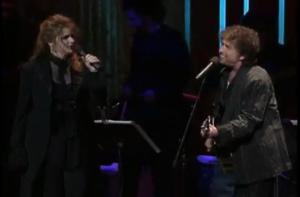As I’ve already mentioned, 1995 was an epic year for the touring Bob Dylan – 116 shows in five distinct tours. I have absolutely no ability to sort out that sort of volume of material (though every single show is out there as a bootleg if you actually wanted to try to bring order to it all). There are certain sites that I use as signposts – Bjorner and Bob’s Boots are both very opinionated and will signal some excellent material – but, of course, that requires a certain outsourcing of my own critical judgments. I wish this wasn’t so, but the fact remains that there aren’t enough hours in the day to do this kind of thing in a single week.
Dylan fans have done remarkable work in terms of making his tours available. Probably every single show after 1974 is available in full somewhere. Better, are some of the curated bootlegs. One of the greatest, for example, is Jewels and Binoculars, which lovingly collects every single recording from 1966 – radio interviews, the Denver Hotel tapes, and live performances from the US, Australia, and Europe (including the fateful UK tour) – into a single 26 CD box set. The thing is astonishing, and you can listen to the entire output of a year like 1966 in a single week.
A similar 1995 set would probably run to about 180 CDs as a guess – a lot of his concerts ran about a CD and a half in length. Thankfully some kind souls have gathered greatest hits packages. One that I benefited from this week was the 5 CD European Tour Anthology. This offers a single complete show (Prague) and then fills it in with the best versions of a lot of songs from that tour, or with the one-offs. Even this captures only the best parts of one of his five tours that year, but it is still a huge headstart.
I have to say, I quite love this 5 CD set. I enjoyed live Dylan in 1995 more than I’ve liked live Dylan since about 1980. I know that this isn’t widely regarded as the peak of the Never Ending Tour, but I thought that there were a ton of great performances throughout the year. That said, I’m less attracted to entire shows. Bjorner particularly singles out the Philadelphia shows of June 21 and 22 as among the best ever from the NET, but I don’t hear it. Yes, they’re good, but, for me, no better than the London shows, or the Prague show. It is true that Dylan works a lot better in 1995 in smaller venues (Philadelphia was in the Theater of the Living Arts – an 800 person venue; London was at the Brixton Academy). Venues that don’t require the band to try to fill in all that space. Basically, I like the 1995 Dylan when you can follow the slide guitar playing of Bucky Baxter.
The other way to approach such a major body of touring material is to highlight the one-offs. Dueting with the Rolling Stones, for example, even when it’s not good. On the first European tour Elvis Costello opened for Dylan on a number of nights, and he also joined him onstage during a few encores (March 30, and March 31 with Carole King and Chrissie Hynde). These break up the routine of the shows, and give something new to focus on. Here’s Dylan and Costello doing “I Shall Be Released”.
To my ear the even better collaboration came at the end of the year. Dylan normally ended his touring year at Thanksgiving, but for whatever reason in 1995 he did a ten date tour in December with Patti Smith as the opening act. Dylan requested that Smith tour with him, then didn’t even bother to meet her for the first three shows. The last seven, however, contain duets during the acoustic portion of the Dylan set, with Smith joining him on “Dark Eyes”, a completely under-rated mid-1980s song from Empire Burlesque. Here they are from the Beacon Theatre in New York. I would’ve loved to have been at this show.
Dylan will “only” do three tours and 83 shows in 1996 (US, Europe, US). Same band for most of the tour (they change drummers after the European leg). I’ll probably write mostly the same post again next week, but instead of Elvis and Patti you get guest stars like Jewel and Aimee Mann. Times change.










